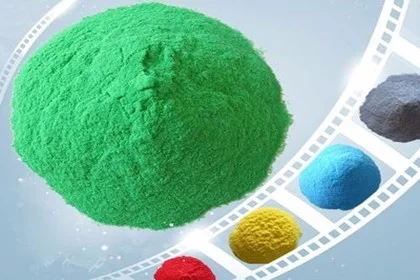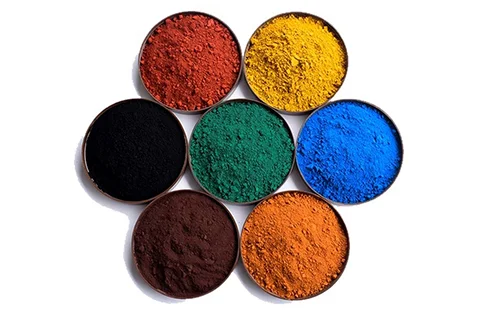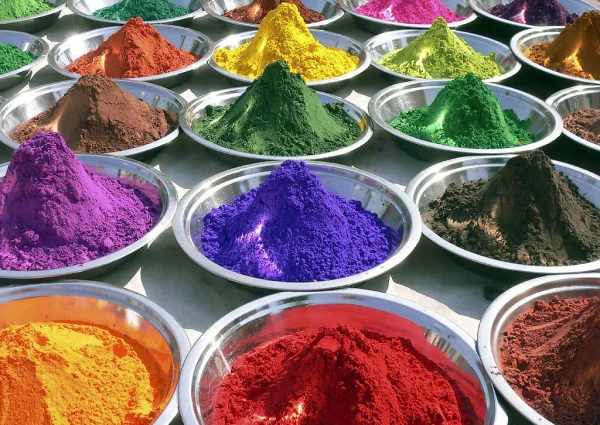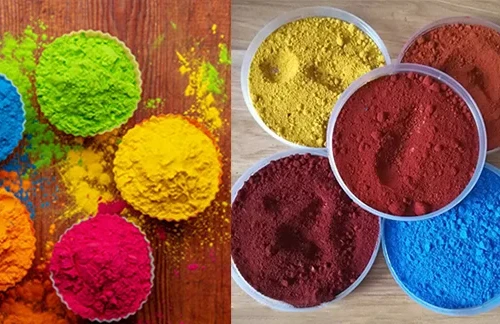What are organic pigments and inorganic pigments?
Pigments refer to the substances used for coloring of objects. They are generally divided into inorganic pigments and organic pigments. Inorganic pigments are the color substances prepared through inorganic chemical reactions; and organic pigments are the color substances prepared through organic synthesis.
I. What are organic pigments?
Organic pigments refer to the pigments made from colored organic compounds. They have a series of pigment characteristics such as colors. They are often extracted from plants and marine animals, such as light blue pigments, rattan yellow pigments and ancient Roman purple pigments from shellfish. Currently, many pigments made from artificially synthesized chemicals can meet the needs for more color categories.

II. What are inorganic pigments?
Inorganic pigments are mainly composed of inorganic substances. Almost all of them are compounds. They are usually complex mixtures, containing metallic components as major molecular components. Generally, inorganic pigments are minerals. They consist of metallic pigments, metal oxide pigments, mixed metal oxide pigments, chromate pigments, silicate pigments, carbonate pigments and sulfide pigments. For example, aluminum powder, copper powder, carbon black, zinc white and titanium dioxide fall into the category of inorganic pigments.

What are the characteristics of organic and inorganic pigments?
I. Characteristics of organic pigments
Organic pigments are mainly composed of carbon-containing organic substances, which have the following characteristics:
1. Vivid colors: organic pigments with vivid colors are suitable for arts and design.
2. Easy to mix: organic pigments have poor stability, so they can be easily mixed with other pigments to produce more colors.
3. Poor light fastness: most of organic pigments are organic compounds with poor molecular stability, so they are prone to fading in the presence of light.
4. Poor heat fastness: organic pigments are not suitable at high temperatures due to their susceptibility to thermal decomposition.
II. Characteristics of inorganic pigments
Inorganic pigments are mainly composed of inorganic substances such as metal ions or oxides, which have the following characteristics:
1. High fastness: most of inorganic pigments are made from inorganic compounds that are relatively stable in daily use, so they have high fastness to light, oil and heat.
2. Dull colors: inorganic pigments have relatively dull colors due to large molecules and poor light adsorption.
3. Difficult to mix: due to high stability, inorganic pigments are difficult to mix with other pigments to produce various colors.

Organic pigments VS Inorganic pigments: What are the differences?
I. Differences between organic pigments and inorganic pigments in chemical structure
Organic colour pigments have complex molecular structures, containing carbon-hydrogen bonds and other elements (such as nitrogen, oxygen and sulfur). Accordingly, organic pigments have rich and vivid colors, high transparency and high stability. In contrast, inorganic colour pigments have simple molecular structures, which are usually compounds composed of metal ions and non-metallic elements. Therefore, inorganic pigments have fewer colors than organic pigments.
II. Differences between organic pigments and inorganic pigments in color
Due to their complex molecular structures, organic pigments generally have rich and vivid colors. For example, organic pigments are particularly purple, yellow, orange, red and blue. Inorganic pigments have fewer colors. They are usually in basic colors, such as red, yellow, blue and black. Inorganic pigments also have higher fastness to light, heat and weather than organic pigments.
Furthermore, organic pigments and inorganic pigments are different in color properties. Inorganic pigments feature fewer varieties, narrower chromatography, lower brightness, dull colors and low color intensity, while organic pigments feature more varieties, wider chromatography, vivid colors and high color intensity.
Inorganic pigments and organic pigments are different in color, luster and effects because of differences in their sources and properties. Inorganic pigments have stable and vivid colors, and they are not prone to fading. Organic pigments are more transparent and shining.
III. Differences between organic pigments and inorganic pigments in fastness
Most of inorganic colour pigments have high heat fastness, durability and solvent resistance. Some inorganic colour pigments may discolor and decompose in the presence of acidic and alkaline substances. Organic pigments generally feature low heat fastness, high-end quality, high durability, high resistance to acidic and alkaline substances, and medium to high solvent resistance.
IV. Differences between organic pigments and inorganic pigments in processability and cost
There are fewer specialized types of inorganic pigments. Some inorganic pigments have high toxicity. However, there are multiple specialized types of commercial organic pigments. In general, organic pigments are non-toxic or less toxic. Thus, inorganic pigments are less expensive than organic pigments.
Inorganic pigments with high fastness to light and high temperature are suitable for outdoor construction, etc. Organic pigments with high transparency and adhesiveness are suitable for inks, cosmetics, etc.
V. Differences between organic pigments and inorganic pigments in safety
Organic pigments contain numerous chemical bonds, so they may release harmful organic substances to affect human health. However, inorganic pigments do not release harmful substances. They are safer for human health. Appropriate pigments should be used, with reasonable protective measures.
VI. Differences between organic pigments and inorganic pigments in compatibility
Inorganic pigments are compatible with other inorganic and organic substances. They are stable in the body, and their colors are not affected by other substances. Therefore, they have good effects in mixing with other pigments. Organic pigments are usually incompatible with other substances, and they are easily affected by other substances, thus leading to loss of stability.
| Main Performance | Organic Pigment | Inorganic Pigment |
| Chemical composition | Organic compounds | Inorganic compounds |
| Variety and chromatography | More varieties, wider chromatography | Fewer varieties, narrower chromatography |
| Color | Vivid colors | Dull colors |
| Color intensity | High | Low |
| Heat fastness | Usually low heat fastness, high quality | Mostly high heat fastness |
| Durability | High | Mostly high |
| Acid and alkaline resistance | High | Some subjects to discoloration and decomposition |
| Solvent resistance | Medium to high | High |
| Specialized type | Many | A few |
| Toxicity (heavy metal) | Non-toxic or low-toxicity | Some with high toxicity |
| Transparency | High | Low transparency and high covering power |
| Cost | High | Low |
What are differences between organic color powders and inorganic color powders in terms of safety?
Organic color powder pigments contain numerous chemical bonds, so they may release harmful organic substances to affect human health. However, inorganic color powder pigments do not release harmful substances. They are safer for human health. Appropriate pigments should be used, with reasonable protective measures.
What are differences between organic color pigments and inorganic color pigments in terms of applications?
1. Applications of inorganic color pigments
Inorganic color pigments are important raw materials for chemicals and materials, with extensive applications. They are mainly applied in dyeing and coloring of buildings, coatings, paints, plastics, rubber, paper, ceramics, glass, etc. They are used the most widely in buildings.
2. Applications of organic color pigments
Organic color pigments are mainly applied in printing inks, cosmetics, dyes, plastics, etc. Due to high color saturation and transparency, they have excellent visual effects. For instance, bright organic pigments are suitable for in textile.

How to choose inorganic pigments or organic pigments?
Both inorganic color pigments and organic color pigments are critical. Inorganic pigments have high fastness to light, high temperature, etc. They are suitable for outdoor buildings. On the contrary, organic pigments have high transparency and adhesiveness. They are suitable for inks and cosmetics. Consumers should understand the properties and applications of pigments in order to select suitable materials and products.
KingChroma is the original inorganic pigment and organic pigment manufacturer and supplier, we provide high quality inorganic pigment powder and organic pigment powder for our customers’ projects.
More Reading:
What Types of Inorganic Pigments and Organic Pigments?
What Approaches Could Be Applied to the Modification of Organic Pigments?
OUR PIGMENT PRODUCTS



